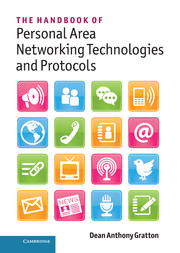Book contents
- Frontmatter
- Dedication
- Contents
- About the Author
- Making My Book Social
- Acknowledgements
- Before We Begin
- About This Book
- Part I What's In Your Area Network?
- Part II The Wireless Sensor Network
- 5 Introducing Low Power and Wireless Sensor Technologies
- 6 Enabling the Internet of Things
- 7 Bluetooth low energy
- 8 Control Your World with ZigBee
- 9 Green, Smart, and Wireless
- 10 The Power of Less
- Part III The Classic Personal Area Network
- Part IV Forthcoming Technologies and Conclusions
- Glossary
- References and Bibliography
- Index
9 - Green, Smart, and Wireless
EnOcean
from Part II - The Wireless Sensor Network
Published online by Cambridge University Press: 05 September 2013
- Frontmatter
- Dedication
- Contents
- About the Author
- Making My Book Social
- Acknowledgements
- Before We Begin
- About This Book
- Part I What's In Your Area Network?
- Part II The Wireless Sensor Network
- 5 Introducing Low Power and Wireless Sensor Technologies
- 6 Enabling the Internet of Things
- 7 Bluetooth low energy
- 8 Control Your World with ZigBee
- 9 Green, Smart, and Wireless
- 10 The Power of Less
- Part III The Classic Personal Area Network
- Part IV Forthcoming Technologies and Conclusions
- Glossary
- References and Bibliography
- Index
Summary
The low power, wireless sensor technology portfolio would not be complete without the inclusion of EnOcean's award-winning patented batteryless, wireless sensor radio technology. In this chapter, we discuss EnOcean's inception and moderately short history, and we provide a review of the Alliance and promoter members’ benefits. EnOcean uses a patented technique to self-power its wireless sensors, and we'll delve deeper into the company's innovative technology and how the technology is being used within the commercial sector later on in the chapter. Likewise, we'll explore EnOcean's product portfolio, the market scope, and numerous user scenarios that place the technology into the real world, ultimately to gain a better understanding of its application-base and purpose. Similarly, we'll look at how EnOcean compares with other low power wireless sensor technologies and review some key differentiators that set EnOcean apart from its competitors.
Overview
Briefly, EnOcean's innovative technology prides itself on a technique known as energy harvesting – the ability of a sensor to derive energy from its environment to power its sensor technology, as opposed to using batteries or any other fixed power source. The technology, or indeed the notion, isn't new; you may recall from Chapter 5, “Introducing Low Power and Wireless Sensor Technologies,” that we discussed numerous techniques used to source energy from natural resources. Renewable energy describes the conversion of natural resources, such as the wind, sunlight, rain, and so on, into a sustainable energy form which can be used to self-power a device. The energy harvesting technique used by EnOcean detects minor variations in the environment, such as change in temperature, ambient light, and the turning on and off of a switch, whereby such differences are sufficient to be converted to enable an EnOcean sensor to accumulate and store energy.
- Type
- Chapter
- Information
- Publisher: Cambridge University PressPrint publication year: 2013



